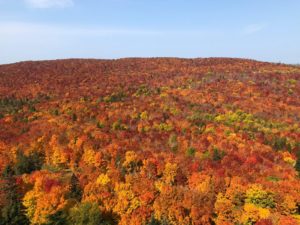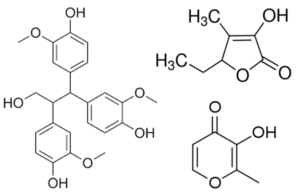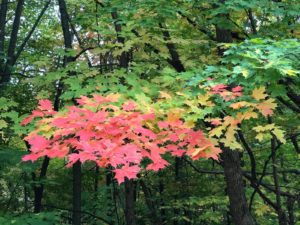It’s spooky season! Whether you call it Autumn or Fall one of the most spectacular plants at this time of year is the Sugar Maple (Acer saccharum). It’s native to Canada and the far north of the United States but is sometimes cultivated abroad.

This has to be about maple syrup right?
As you might have guessed from the name this tree is the primary source of maple syrup. Other maple species can be used but generally the best syrup is produced from the sugar maple. Between March and early May (depending upon the region), a tap is inserted into the tree so it’s just below the bark and the sap drips into a bucket. After collection, the sap is boiled down to make the syrup- about 40 L is needed to make 1 L of syrup! Conveniently this process also destroys any bacterial growth and commercial products can have a shelf life of ~ 1yr. The maple syrup is then graded before being sold. Grading is based upon the internal transmittance of a 10 mm path length of the syrup at 560 nm.
Golden 75%+
Amber 50.0-74.9%
Dark 25.0-49.9%
Very dark <25%
The flavours of maple syrup are complex and depend upon when the sap is harvested. The sweetness comes from sucrose, but the other main flavour components have been identified as 5-ethyl-3-hydroxy-4-methyl-2(5H)-furanone, strawberry furanone, maltol and quebecol, however not a lot of research has been done into this area so there’s likely to be several more!

Classic autumn colours:
As well as its syrup this tree is also known for its autumn colours, with maple forests changing to bright oranges and reds before shedding their leaves. Chlorophyll stops being produced as the temperature and daylight hours reduce and begins to degrade into colourless tetrapyrroles. Yellow and orange colours are produced by flavonoids and carotenoids that are always present in the leaves but break down at a slower rate than chlorophyll and hence become visible as the chlorophyll degrades. However the red colours arise from anthocyanin production. This is triggered by an increase in sugar concentration in the leaves reacting with sunlight and a decreased phosphate level compared to the growing season. This is why bright, cool (but not freezing) autumn days usually result in the best colour displays.

The real world making itself known:
Unfortunately these stunning trees are being heavily affected by climate change. Unusually the seeds need a period of dormancy where the temperature is only just above freezing for several months before they germinate. With the rising temperatures and freak weather events, the habitat this tree can live and breed in is reducing. They’re also very susceptible to pollution, showing more damage than their neighbours from acid rain and raised salt levels in urban areas from road gritting. Their disappearance would be a disaster for many forests as they are extremely deep rooted trees, pulling water up from lower soil layers to the dryer upper layers hence supporting the survival of many shallow rooted species.
